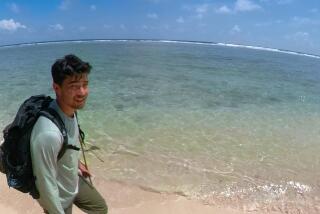Slain Ecuador Missionaries’ Plane Found : Amazon: Discovery inspires a family crusade to recover the Piper, salvage as much of it as possible and piece it together as a memorial for the five men, who were killed in 1956.
- Share via
TONAMPARE, Ecuador — Five American missionaries flew into Ecuador’s Amazon jungle 38 years ago in a yellow Piper. A week later they were all dead, speared by primitive Indians who believed they were cannibals.
The Huaorani Indians demolished the single-engine plane on a small landing strip on the Curaray River that the Protestant missionaries had code-named Palm Beach.
Days after the Jan. 8, 1956, killings, another missionary flying over the site saw no traces of the plane. Everyone assumed that violent tropical storms had washed it downriver.
But last June, amid the martyred missionaries’ graves, two members of the clan who had done the killing stumbled on a piece of metal sticking out of the sand near Palm Beach. They uncovered the front lower fuselage of the Piper, which had been piloted by Nathanael Saint of Huntingdon Valley, Pa.
The discovery inspired a family crusade to recover the Piper, salvage as much of it as possible and piece it together as a memorial to honor the five dead men.
The Saints hope this tribute will encourage future missionaries and further understanding between two vastly disparate cultures. The number of American missionaries has declined worldwide in the past four decades. Some are still being martyred.
Saint’s sister, Rachel, 80, has lived peacefully with the Huaorani since 1958, when she moved to Ecuador as a translator with the Summer Institute of Linguistics (Wycliffe Bible Translators). “Ironically, the Indians are very excited about the find,” she said. “It’s important to them, because the event marks an end to their killing.”
After the initial find, Nate Saint’s son Stephen, 43, of Ocala, Fla., took charge of the search for the rest of the wreckage.
“The strange thing was that I had just met a pilot in Russia who told me his dream was to find and salvage Dad’s plane,” he said. “So when I heard, I got right on a plane to Ecuador.”
Joining in the search are Steve’s son Jaime, 17, and his brother, Philip, along with several Huaorani and William Clapp, a pilot for Mission Aviation Fellowship in Shell, Ecuador. Nate Saint piloted the plane for the fellowship.
The team is steadily recovering half-buried, scattered parts. Each recovery stirs memories of a mission that began with hope and ended in horror.
Discovery of the plane’s fragments, said Steve Saint, is “almost as if God is saying, ‘I want you to remember what happened here.’ ”
All five victims were young. Nate Saint was 32; James Elliot of Portland, Ore., 28; Edward McCully of Milwaukee, 28; Peter Fleming of Seattle, 27, and Roger Youderian of Lansing, Mich., 31.
For several months before the landing at Palm Beach, the missionaries periodically flew from Shell over the Huaorani village in the Amazon rain forest, or Oriente.
To win the trust of the reclusive Indians, the men dropped gifts of machetes and aluminum kettles. In return, the Huaorani gave the Americans gifts, including a live parrot.
Most Huaorani are primitive, semi-nomadic hunters. They have fiercely guarded their territory for centuries, earning a reputation for savagery.
The Christians were fully aware of the danger, so they kept their mission a secret.
Their landing was uneventful. For four days, they saw no people. On the fifth day, three naked Huaorani, two women and a man, walked out of the jungle. Fist-size balsa wood ornaments hung in their distended earlobes.
Initially, the meeting was amicable. The missionaries cooked hamburgers for their visitors, shared insect repellent with them, even took them for rides over the dense green forest in the yellow Piper, which the Indians named the “wood bee.”
The Americans showed the Huaorani a photograph of Dayuma, a woman from their tribe who had fled many years before, during a wave of intra-tribal killings.
The missionaries’ friendly gestures didn’t save their lives.
George, the Americans’ nickname for the Huaorani man who had greeted them, told the tribe that the white men were cannibals who had attacked him.
This belief was reinforced by the photograph of Dayuma. George said the image proved that the missionaries had possession of her spirit.
Two days after the missionaries and the Huaorani met, six tribal warriors attacked Palm Beach. One by one, they slaughtered the missionaries with 9-foot spears. Although the missionaries were armed, they chose to fire their guns into the air instead of shooting the Indians.
In 1958, two Huaorani women told Rachel Saint and Elisabeth Elliot, James Elliot’s widow, that the Indians had come to recognize that the killings were a mistake. For his lies, George was speared to death.
The Huaorani and American women returned with Dayuma to the tribe to finish the missionaries’ work. Rachel Saint and Dayuma still live in the village of Tonampare, a muddy clearing ringed by tin-roofed shacks near Palm Beach.
Differing experts estimate the number of Huaorani today at 600 to 1,300. Most of them live on a reservation in Ecuador’s Yasuni National Park and have abandoned their Stone Age ways.
More to Read
Sign up for Essential California
The most important California stories and recommendations in your inbox every morning.
You may occasionally receive promotional content from the Los Angeles Times.













